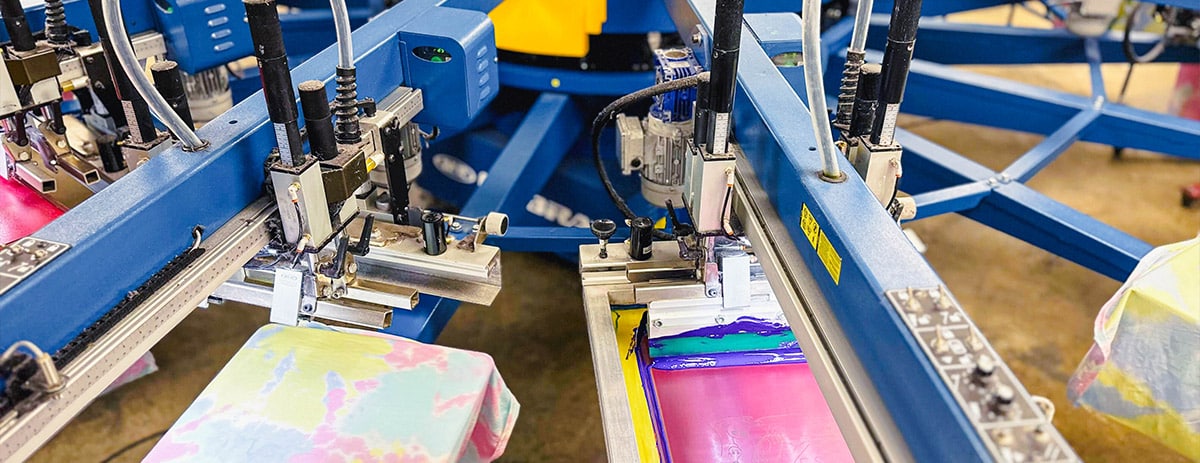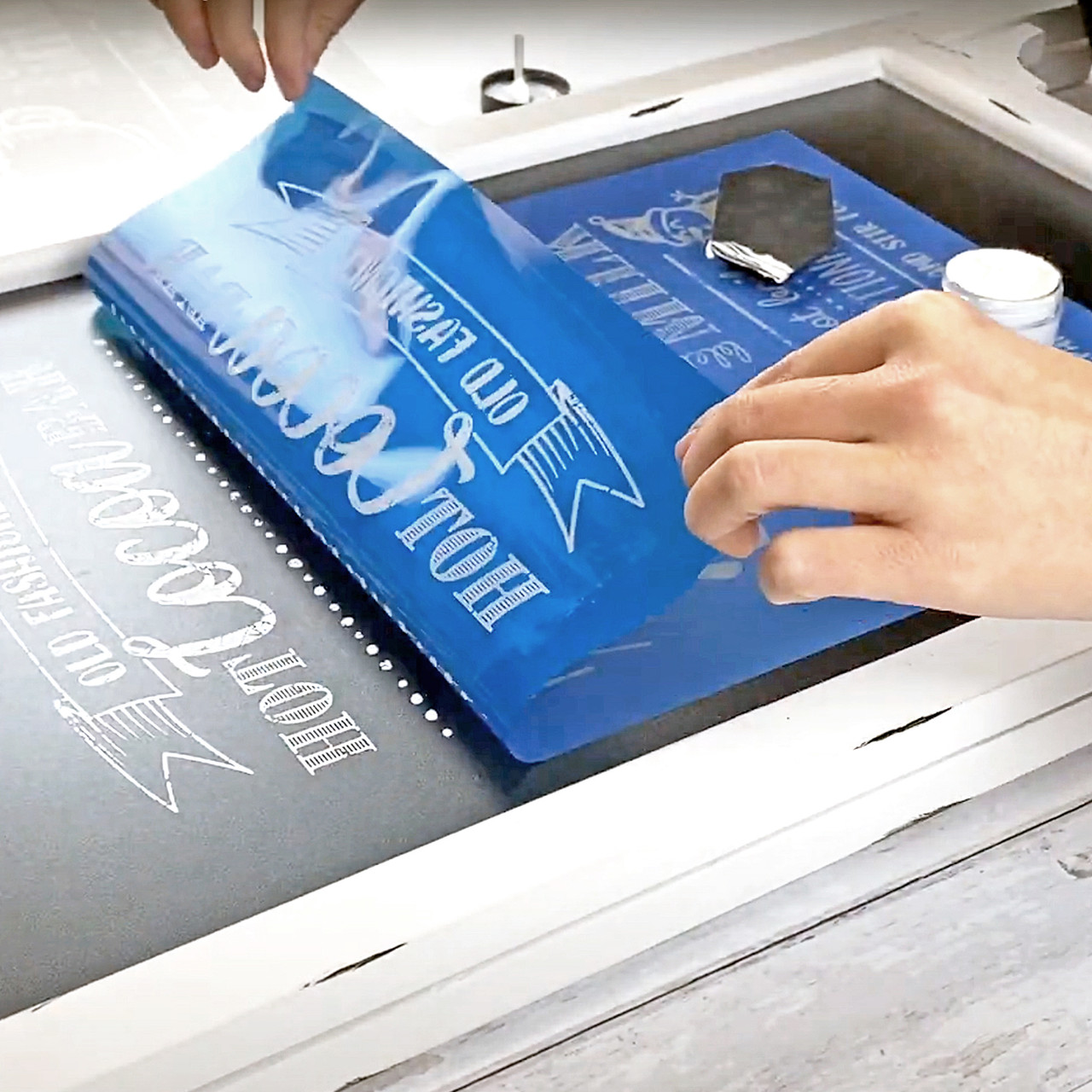Silk Screen Printing for Bold and Lasting Designs
Silk Screen Printing for Bold and Lasting Designs
Blog Article
Screen Printing Uncovered: Whatever You Need to Find Out About T-Shirt and Garment Printing Techniques
Display printing is an interesting approach that integrates art with strategy, offering countless possibilities for creativity. Prepared to explore the important aspects that make screen printing an art form?
The Fundamentals of Screen Printing: Exactly How It Works
When you dive into screen printing, you'll uncover it's both an art and a science. At its core, display printing involves developing a stencil, or screen, that allows ink to go through only in details areas (screen printing kit). You begin by picking your design and preparing your screen with a light-sensitive solution. When you expose this emulsion to light, it hardens, leaving your design as an unfavorable room.
Placement the screen over the textile, after that make use of a squeegee to push ink via the screen onto the garment. Each step is crucial, and understanding them will certainly elevate your display printing skills, changing easy garments into one-of-a-kind, meaningful items.
Kinds of Screen Printing Strategies
When you understand the basics of screen printing, it's time to check out the numerous strategies that can elevate your layouts. One preferred method is conventional screen printing, where ink is pressed through a stenciled display.
If you're going for fine details, think about discharge printing. This method gets rid of color from the textile, leaving a soft, vintage appearance. Another choice is plastisol printing, recognized for its sturdiness and dazzling shades, making it a favorite for lots of brand names. Finally, explore halftone printing to develop gradient results and intricate designs. Each strategy has its one-of-a-kind charm, so don't hesitate to try them bent on find what suits your design best!
Important Tools for Screen Printing
To attain magnificent lead to display printing, having the right tools is fundamental. You'll need a durable screen printing frame, which holds the mesh that transfers your design onto the garment. Next, buy top notch squeegees; these are important for applying ink equally across the display. You'll likewise call for a great exposure device to develop your displays, as well as a washout cubicle for cleaning them after use. A dependable warmth source, like a conveyor clothes dryer or heat press, is important for healing your prints to assure long life. Don't forget a proper workspace, equipped with tables and storage for your supplies. Finally, protective gear, such as gloves and masks, will certainly keep you risk-free from chemicals and inks. With the right devices, you'll be well on your means to creating professional-quality prints.
Choosing the Right Inks and Materials
When selecting inks and materials for display printing, you need to consider the kind of ink that works best for your job. Consider material compatibility to ensure your styles look excellent and last long. Explore environment-friendly ink alternatives to make your printing process extra sustainable.
Sorts Of Display Inks
Picking the right screen ink is vital for attaining dynamic, sturdy prints that meet your job's requirements. There are a number of kinds of screen inks to analyze. Plastisol ink is prominent for its convenience and ease of usage, giving superb color opacity on dark textiles. Water-based ink, on the various other hand, supplies a softer feel and is eco-friendly, making it optimal for those seeking to lessen their environmental effect. Release inks remove dye from the textile, resulting in a soft, vintage look but call for particular handling. Specialized inks, such as glow-in-the-dark or metallic, can add special impacts to your styles. Review your job demands and pick the ink that lines up ideal with your preferred end result.

Fabric Compatibility Considerations
Recognizing textile compatibility is vital for accomplishing top notch display prints, specifically considering that different materials respond uniquely to various inks. Always examine your inks on sample textile to ensure they stick appropriately and preserve shade stability. In addition, maintain in mind that fabric weight and texture can affect the final end result, so choosing the appropriate ink and material combination is important for your job's success.
Eco-Friendly Ink Options
Green inks are coming to be a popular choice for display printers who intend to reduce their environmental influence while maintaining high quality. When picking inks, think about water-based inks, which are much less hazardous and less complicated to tidy up compared to conventional solvents. These inks bond well with fabrics, delivering vibrant results without toxic chemicals. You may also check out eco-solvent inks that use less unpredictable organic compounds (VOCs), making them a more secure option for both your health and wellness and the world.
In addition, seek inks made from renewable energies, such as soy or vegetable-based choices. By selecting the ideal inks and products, you'll not just produce magnificent styles however also add to a much more lasting printing procedure. Make the switch, and your prints will certainly show your dedication to the atmosphere!
Preparing Your Layout for Screen Printing

File Style Requirements
To assure your design looks sharp and dynamic on fabric, you'll need to pay very close attention to submit format demands for screen printing. Start with vector data like AI or EPS, as they can be scaled without shedding high quality. If you use raster images, decide for high-resolution data, such as TIFF or PNG, ideally at 300 DPI. Stay clear of using JPEGs, as they can lose clearness when resized. Additionally, ensure your design has a clear history to avoid undesirable white edges on your prints. Ultimately, maintain color modes in mind; CMYK is conventional for display printing, so convert your RGB develops appropriately. By complying with these standards, you'll set your artwork up for an effective print.
Shade Separation Strategies
Shade splitting up is a crucial action in preparing your layout for display printing, and understanding it can substantially boost your print quality. You'll need to damage your design into private colors, as each color requires a different screen during printing. This precision not just ensures exact color representation but also streamlines the printing process.
Resolution and Dimension
Achieving the very best lead to screen printing begins with ensuring your layout has the right resolution and dimension. Ideally, your artwork must be at least 300 DPI (dots per inch) for sharp, clear prints. If you make use of reduced resolution, your end product may look less than professional and pixelated.
When it comes to size, take into consideration the measurements of your print location. Layout your art work to match the final print dimension, preferably creating it in the real measurements you'll be publishing. This way, you'll avoid any kind of unanticipated scaling issues.
Always examine your design in both vector and raster styles. Vector graphics can be scaled without shedding top quality, making them optimal for display printing. Preparing appropriately will ensure your style looks incredible on every garment!
Step-by-Step Screen Printing Refine
Display printing is a vibrant process that permits you to produce vibrant designs on different surface areas. To get begun, you'll require a display, solution, and your chosen ink.
Put ink onto the display and utilize a squeegee to push the ink with the pattern onto the textile. Raise the screen carefully and allow the print completely dry. You have actually successfully screen published your design.
Tips for Effective Screen Printing Projects
While you're diving into your display printing tasks, keep in mind that prep work is essential to success. Begin by collecting all your products-- inks, garments, mops, and screens. A clean office assists protect against undesirable mistakes, so clean up prior to you start.
Next, verify your artwork is high-resolution and properly sized for your garment. Evaluate your display for appropriate exposure and clean it thoroughly to stay clear of smudges. When mixing your inks, adhere to the manufacturer's guidelines to accomplish the ideal consistency.
Throughout printing, use even pressure with your squeegee for constant results. Don't rush; take your time to confirm each print fulfills your standards. After printing, let your garments dry entirely before handling or packaging them.
Last but not least, constantly keep a sample of your benefit future reference. In this manner, you can evaluate your development and boost your methods gradually. Happy printing!

Frequently Asked Questions
The length of time Does It Take to Establish a Display Printing Job?
Setting up a display printing job typically takes around 30 minutes to an hour. You'll this post prepare the screens, mix inks, and adjust the click here now press. The time varies based upon complexity and experience, so stay arranged!
Can I Print on Different Material Enters Utilizing the Same Strategy?
Yes, you can print on various fabric types making use of the same strategy, however you'll need to change your settings and inks. Some textiles absorb ink in a different way, so trying out assurances the most effective outcomes for each and every product.
What Are Typical Errors to Stay Clear Of in Display Printing?
When screen printing, avoid common blunders like using the wrong ink, neglecting correct exposure times, or avoiding pre-press checks. Constantly check your configuration and keep tidy displays to guarantee quality outcomes each time.
How Can I Appropriately Tidy and Keep My Display Printing Tools?
To properly clean and keep your display printing tools, you must frequently wash displays with proper solvents, inspect squeegees for wear, and ensure all tools are stored dust-free and dry. Uniformity protects against expensive repair work and enhances performance.
Is Display Printing Eco-friendly Contrasted to Other Methods?
Display printing can be more eco-friendly than other methods, especially if you utilize eco-conscious materials and water-based inks. By picking lasting products and practices, you decrease waste and lessen your influence on the earth.
Screen Printing Uncovered: Whatever You Required to Know Regarding Tee and Garment Printing Strategies
At its core, display printing entails producing a pattern, or display, that allows ink to pass with just in certain locations. Setting the display over the textile, after that use a squeegee to push ink through the screen onto the garment. One popular technique is traditional screen printing, where ink is pressed with a stenciled display.When selecting inks and products for display printing, you require to take into account the type of ink that works finest for your project.
Report this page